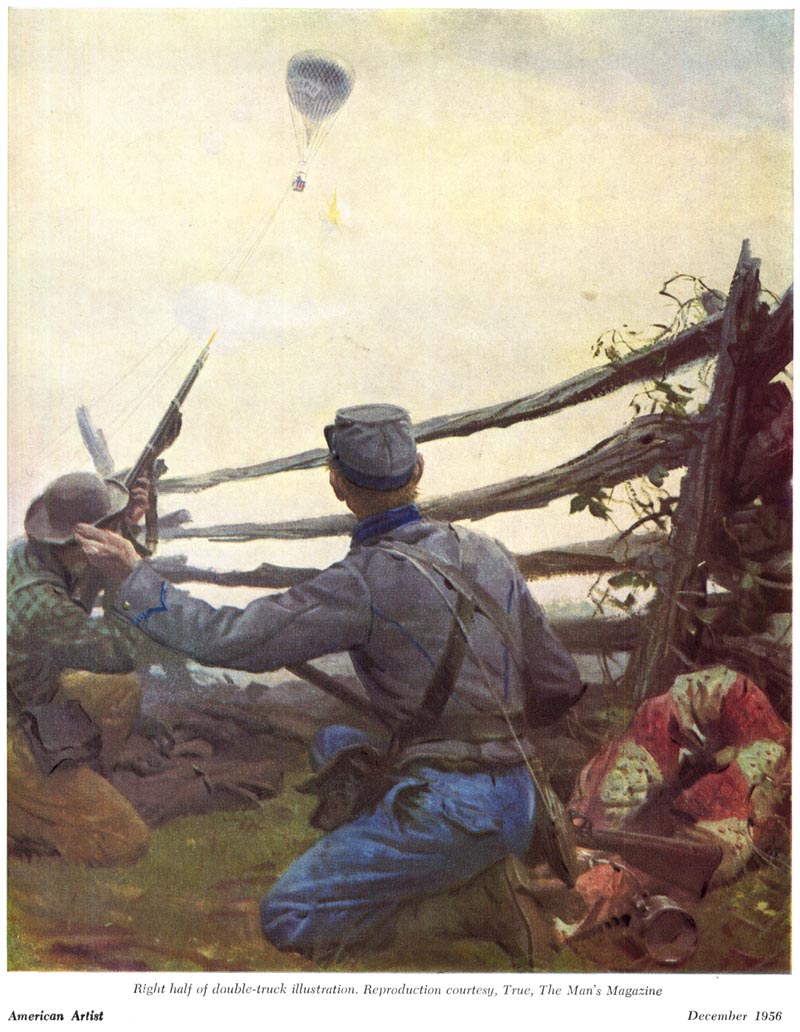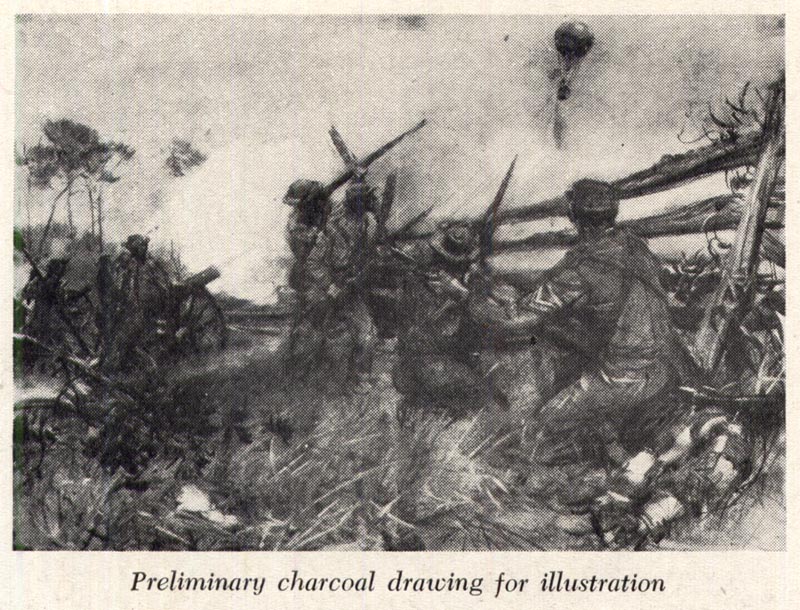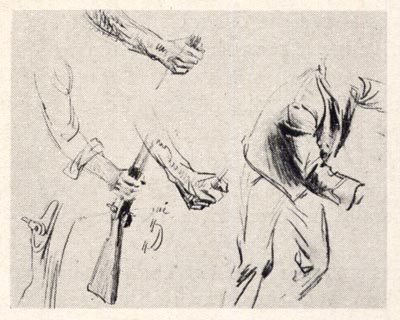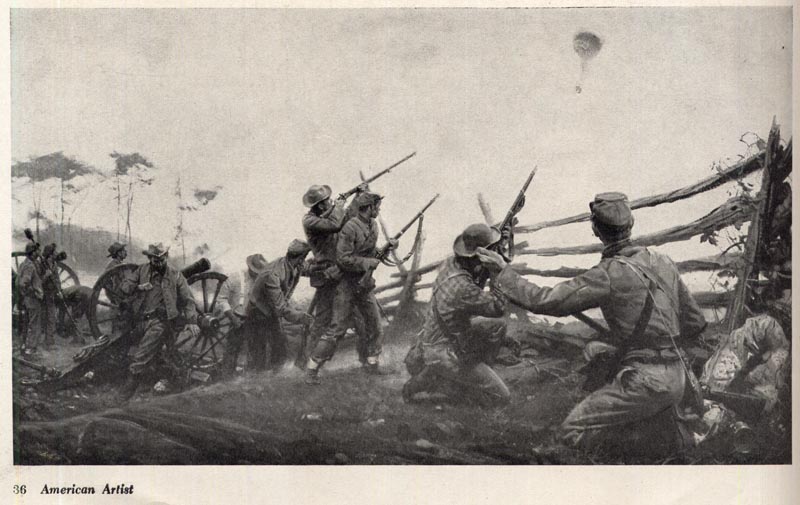"There is an explanation for [Lovell's] mature direction: the happy combination of an engaging personality, a thorough grounding in his craft, a dedication to his chosen profession, and workmanlike method of execution."

"When I interviewed him in his handsome studio near Westport, Connecticut, some months ago, I saw many things that added up. Surrounding a job on the easel (and not exposed for my special benefit) were rough sketches, reference books, detailed drawings, and a much-marked manuscript."

"These little evidences, this concern for thoroughness of research is no pose. For Tom Lovell limits the number of commissions he accepts each year to allow time for his study of the particular problem; time to sit and think; time for numerous roughs, often so abstract only he can decipher them; and time for making a half-scale charcoal drawing in which, as readers can see from the one we have reproduced, all the values are worked out and the final design organized."

"This is the monochrome drawing he submits to the art director, though occasionally he offers two or more. In any event Tom seldom has to make revises, so completely has he projected the idea, the form, and even the illusion of color."

"While developing this charcoal drawing Lovell told me that he constantly thinks in terms of color - its overall temperature and the mood. By using a flexible medium, such as charcoal in which values can be adjusted so easily, the illustrator can anticipate problems of subtlety and contrast before projecting the composition on canvas."

"In Tom Lovell's case this accounts, in large measure, for the freshness and directness his original paintings present which, in turn, is retained in the process engraving and in the printed image."
* My Tom Lovell Flickr set.
*ALSO* A new CAWS is now posted on Charlie Allen's blog.
One of my all time favorite illustrators. Thanks for your thorough approach to such a gifted artist.
ReplyDeleteIt sure must have been nice to have that kind of time to work on a piece.
ReplyDeleteFrank; You're most welcome!
ReplyDeleteLarry; Now that we have a general idea of what artists like Lovell were getting for a f/c dps in the mainstream mags back around 1950 (likely $1k-$2k) its easier to appreciate how Lovell could choose the luxury of taking his time. Being fairly prolific during those days, I would guess he was making 4 or 5 thousand dollars a month. What would be the modern equivalent? 10 to 20 Grand a month? I'd be willing to take my time and enjoy each painting as well if I were pulling in those kinds of bucks! ;^)
Leif, an interesting observation on how much illustrators made in those days. During the 60's, Bob Peak was making over $200,000. a year, which was told to me by a reliable source. That was still pretty huge in the 60's, even though photography was taking away a lot of illustration business. However, I was also told that he often did 2 and if the job really paid well, 3 finished version for one assignment, rather than going back and forth with changes on pencils and color roughs, etc. In his case, the A.D.'s seemed to like choosing from the finishes. I'm not surprise that he might have eventually sold the other version(s) later.
ReplyDeleteA friend of mine in S.F., was called the "storboard machine", because he could crank out more frames in a shorter amount of time than anybody in S.F. and maybe the whole country. They were always good enough, but not really great. But, he was the go to guy for speedy storyboards. Many A.D.'s were looking for volume and consistency to pull them out of a jam, when they had to make a presentation and WOW their client or potential client with tons of concepts. Bottom line, my friend made big bucks, had plenty of work, and seemed to be satisfied as primarily a storyboard illustrator. Like most of us illustrators, he worked a lot of all nighters and weekenders. He died of a heart attack, in his prime, around his late 40's or very early 50's.
But, I think it's more about each illustrator's personality. The money was the prime motivator for some illustrators, seeing their work reproduced nationally was more important for others, but the ones I didn't really understand, were those that were busy, made good money, got their share of national exposure and awards, yet bitched and complained about being unappreciated as an illustrator.. considered themselves "prostitute". Maybe they weren't informed about the reality of the role of the Illustrator. (?) ;-)
Frankly, I respect Lovell for not trying to make even more money, which he probably could have made, by cranking out more illos faster... or maybe his work wouldn't have been nearly as well done and sought after, had he stepped up the pace. (?)
Tom Watson
Thanks for that, Tom; You raise many excellent points about the nature of this business. The most enviable illustrators are those who have unwaveringly followed their personal vision, had both critical and financial success, and do not end up being just the flavour of the month, but actually enjoy long, enduring careers. Needless to say, out of the thousands and thousands of professional illustrators who plied their trade over the last hundred years, perhaps... a hundred? have achieved that status.
ReplyDeleteFor the rest of us, the name of the game is scaring up enough work to keep the wolf from the door. I'm with you when it comes to that last group of illustrators, the ones I have in the past described as 'artistes'. I admire their determination to create only what their muse inspires them to create, but I always figure they must be hiding a wealthy spouse in the closet. Either that or they're immune to cold weather and have an passion for cabbage and brown rice!
Small world.....
ReplyDeleteBob Peak's son Matthew lives by me a few miles away. He contacted me the other day " glad" that there was another pro in our sleepy back woods. His style is so different than his dad's. When I see him, I'l ask him...so how much did your old man make?
Also, I was friends with Stan Fleming who was a story board wizard around the SF bay area. He was making at one point ( cuz he told me ) $30,000 a month. While I was at ILM, he was storyboarding Indiana Jones and the Temple of Doom... He died of a heart attack putting out a fire at his home. Really nice guy who was always busy and put work first...often times above friendship sad to say.